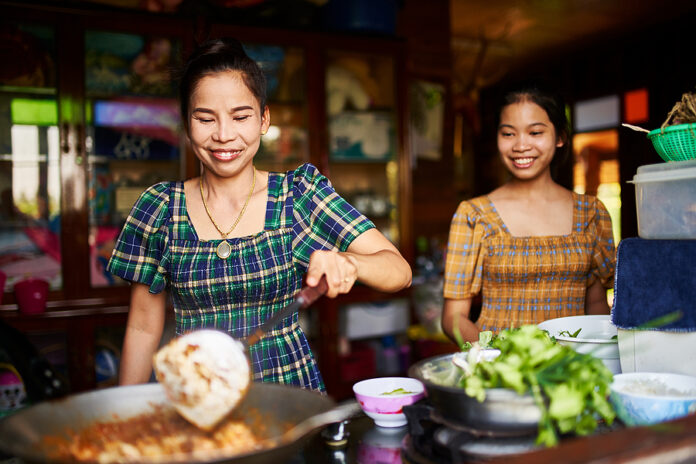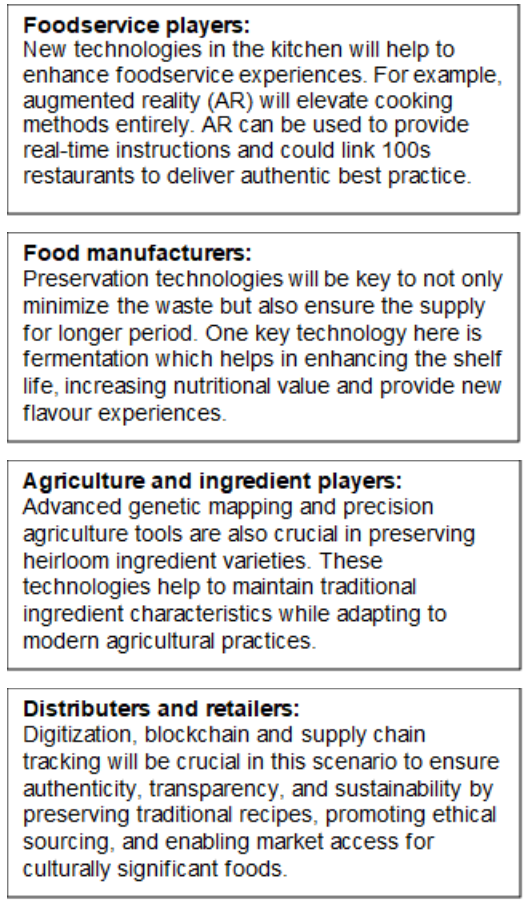
By FutureBridge
Key Takeaways:
- Gastronomic heritage under threat: Over 70% of culinary traditions face extinction due to the rise of fast food and industrialized food production.
- Balancing tradition and innovation: Preserving gastronomic heritage requires a delicate balance between traditional practices and technological advancements.
- Importance of authenticity: Consumers value authentic, traditional food and are willing to pay a premium for products with geographical indications.
Amid the rapid changes of the modern world, a sobering statistic emerges — over 70% of our treasured culinary traditions are on the brink of extinction within the next century. This startling revelation underscores a critical issue — our gastronomic heritage is under siege. The rise of fast food empires and industrialized meal production, while offering convenience, is eroding the intricate tapestry of flavors and stories that define cultures. These culinary shortcuts not only risk wiping out the diversity of our food heritage but also threaten the sustainable practices that have long been the backbone of traditional cuisines.
Introduction
In a world where the pace of life is ever accelerating, the real challenge lies in embracing technological innovations without losing our culinary soul. As consumers increasingly resist synthetic food solutions, a movement toward preserving authentic culinary traditions gains momentum. In this evolving scenario, the focus shifts to safeguarding our gastronomic heritage while food supply systems seek new methods to stabilize. The skepticism towards synthetic alternatives underscores the critical role of modern technology in this endeavor.
However, this journey is fraught with challenges. Integrating technology with cultural preservation requires a delicate balance, emphasizing the need to protect the diversity and sustainability inherent in traditional cuisines. Leveraging innovations to enhance resilience and adaptability while maintaining authenticity is crucial. This article explores how technological advancements can preserve traditional recipes and practices, emphasizing the blend of tradition and innovation needed to revitalize heritage cooking and sustain cultural culinary practices. It highlights how embracing technology can preserve the rich tapestry of flavors, stories, and sustainable practices, ensuring they thrive and adapt to future needs while retaining their authentic essence.
Drivers of gastronomic heritage preservation
Consumers clearly value the “real” thing. They trust authenticated solutions and formulations. A study from the European Commission underscores this sentiment, revealing that products with geographical indications command double the unit sales value of non-certified counterparts. In nations deeply rooted in culinary traditions, veering from established sourcing and cooking practices is tantamount to cultural sacrilege. This steadfast commitment to gastronomic heritage not only preserves cultural identity but also safeguards economic value and consumer trust in the food industry.
The challenge
Many countries aim to preserve their traditions and heritage in the food supply chain. However, growing populations and decreasing resources necessitate innovative food production methods. The rise of conscious consumerism drives demand for transparency and authenticity in food production. Consumers increasingly seek information about their food’s origins, production methods, and the stories behind it, prompting food producers to prioritize sustainable and authentic practices for market advantage and customer loyalty.
While synthetic foods may not be the solution, food producers will explore techniques to preserve ingredients, enhance efficiencies and yields, and localize methods. The challenge is to balance preserving traditional culinary practices with modernizing food production. For businesses, this means investing in R&D to develop technologies that replicate traditional flavors and textures without compromising quality.

Innovations shaping gastronomic heritage
Gastronomic heritage fuels innovation in the food industry, inspiring new products, cooking techniques, and dining experiences. The fusion of modern technology with traditional practices will help define novel cuisines and immersive dining experiences, setting new industry standards. These innovative cuisines exemplify the meeting of tradition and innovation, while sustainable food sovereignty transforms production through precision agriculture and aquaponics, driven by the demand for minimally processed, nutritious foods.
Synthetic sustenance, such as lab-grown meats and plant-based alternatives, addresses food scarcity and environmental challenges, despite initial consumer resistance, highlighting the industry’s commitment to sustainability and its responsiveness to contemporary demands.
Preserving our gastronomic roots
To foster a future where food is not only nourishing but also sustainable and deeply connected to cultural identity, preserving our gastronomic roots is essential. This involves documenting traditional recipes, supporting local farmers, and promoting heirloom crops. Blockchain technology can ensure the provenance and authenticity of these crops, while community engagement and collaborations with conservation organizations bolster these efforts
The interplay of tradition and innovation
The interplay of tradition and innovation is crucial in shaping future food sustainability. Integrating modern technologies like AI and precision agriculture with traditional practices enhances efficiency, ensures food safety, and maintains the nutritional and cultural integrity of foods. This fusion revitalizes heritage cooking and adapts it to contemporary needs
Influence of cultural heritage on consumer expectations
Cultural heritage significantly influences consumer expectations from food brands. Consumers increasingly seek products that reflect authentic, traditional flavors and sustainable practices. This expectation drives food brands to maintain transparency, source ingredients responsibly, and honor culinary traditions, thereby building brand loyalty and trust.
Technological Innovations
Thoughtfully integrating technology with tradition, provides a unique opportunity to not only preserve but also revitalize the rich, sustainable practices of heritage cooking. Cutting-edge technologies are being adopted to maintain the integrity and sustainability of traditional foods.
- AI-driven kitchens: AI tools optimize cooking processes, enhance efficiency, and allow chefs to focus on creativity. Intelligent kitchen appliances streamline operations and improve dish quality by leveraging data-driven insights.
- Blockchain for transparency: Blockchain technology ensures the authenticity of food products by providing transparent, immutable records of food provenance. This fosters trust among consumers and supports traditional food practices.
- Virtual and augmented reality: These technologies offer immersive culinary experiences, teaching traditional cooking techniques and celebrating cultural heritage in engaging ways. They enable consumers to explore the origins and preparation of their food virtually.
- Precision agriculture: Advanced agricultural technologies, including vertical farming and aquaponics, support the sustainable production of ingredients essential to heritage cooking. These methods ensure year-round availability of high-quality, environmentally friendly ingredients.
- Personalized nutrition: AI and genetic analysis provide personalized dietary recommendations, aligning traditional diets with modern health needs. This approach helps preserve traditional foodways while adapting them to contemporary lifestyles
Innovation investment
Continuous investment in R&D is crucial to developing technologies that support traditional food practices while enhancing efficiency and sustainability. Companies should create a robust pipeline of innovative solutions aligned with authenticity and sustainability values.
Collaborative ecosystems
Creating ecosystems that foster collaboration between tech companies, food producers, and agricultural communities is essential. Successful partnerships and collaborative projects can lead to the preservation and enhancement of culinary traditions.
Regulatory and policy frameworks
Government policies and regulations play a vital role in supporting the preservation of gastronomic heritage. Industry players can influence and adapt to these frameworks by engaging in policy advocacy and compliance initiatives.
Trends and emerging technologies
Future technologies could revolutionize the preservation of culinary heritage, such as advanced biotechnology for ingredient synthesis, AI for predictive crop management, and robotics for precision agriculture. These technologies can address current challenges and open new opportunities for the food industry.
Evolving consumer expectations
Consumer expectations around sustainability and authenticity are evolving, with increasing demand for hyper-local food sourcing and personalized nutrition. These trends will impact food production and marketing strategies significantly.
Preserving culinary heritage: imperatives for food industry players
The benefits of technological integration in preserving culinary traditions are substantial, but it is also essential to recognize the role of community and collaboration in preserving gastronomic heritage.
Engaging with the community
Engaging with local farmers, participating in on-farm conservation programs, and supporting community-run seed banks are vital steps towards maintaining genetic diversity and promoting the cultivation of heirloom crops. Organizations like Seed Savers Exchange and Seed Change play a crucial role in these efforts, offering a platform for collaboration and education among farmers.
Perspectives
We’ve explored how technology serves as both a preserver and innovator in the realm of gastronomic heritage. From enhancing agricultural practices to creating personalized consumer experiences, technology offers a myriad of opportunities to sustain and celebrate our culinary traditions. As we continue to face global challenges like food sustainability and climate change, these technological interventions will play a crucial role in ensuring that our gastronomic heritage thrives in a modern context.
FutureBridge strongly supports the belief that the future of food lies in the delicate balance between preserving our rich gastronomic heritage and embracing technological advancements. Companies that successfully blend tradition with innovation will not only meet consumer demand but also set themselves apart in a competitive market. They will be able to offer products that are both authentic and sustainably produced, appealing to a broad spectrum of conscientious consumers.
By prioritizing authenticity, sustainability, and innovation, we can ensure that traditional culinary practices continue to thrive, providing a flavorful and culturally rich future for generations to come.
FutureBridge is a techno-commercial consulting and advisory company. We track and advise on the future of industries from a 1-to-25-year perspective to keep you ahead of the technology curve, propel your growth, Identify new opportunities, markets and business models, answer your unknowns, and facilitate best-fit solutions and partnerships using our platforms, programs, and access to global ecosystems and players.








